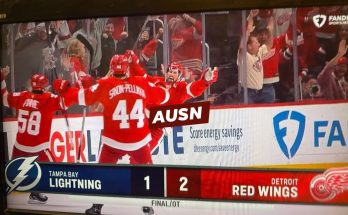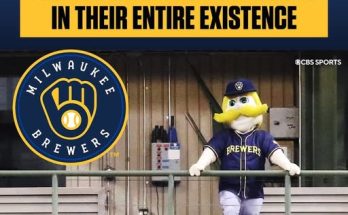Breaking: The Golden State Warriors have signed Damian Lillard. After being released by the Milwaukee Bucks and becoming an unrestricted free agent, Damian Lillard signed a two-year, $51.6 million contract with the Warriors.
After months of speculation, the NBA landscape was jolted when news broke that Damian Lillard, one of the league’s most dynamic scorers and longtime Portland Trail Blazers icon, had signed a two-year, \$51.6 million deal with the Golden State Warriors. The shocking move came just days after Lillard was released by the Milwaukee Bucks, following an Achilles injury that ended his season and brought into question whether his days as an elite player were over. Yet Golden State, in a bold move to extend their championship window, saw an opportunity and pounced. The signing not only sends ripples through the Western Conference but also marks a fascinating new chapter in the storied career of one of the NBA’s most compelling stars.
Lillard’s journey to Golden State is as dramatic as it is unexpected. After being traded from Portland to Milwaukee in a blockbuster deal the year prior, Lillard teamed up with Giannis Antetokounmpo in what many viewed as a championship-caliber pairing. Things started strong, but injuries and chemistry issues slowly derailed the Bucks’ title hopes. Lillard’s Achilles injury, compounded by a blood clot scare earlier in the season, ended his campaign and prompted the Bucks to waive him in a surprising cap-space move designed to restructure the team around a younger, more versatile core. While Lillard’s \$113 million remaining contract was stretched over five years under the NBA’s waive-and-stretch provision, it left him a free agent for the first time in his career.
In free agency, Lillard had options. The Miami Heat, long rumored as his preferred destination, expressed renewed interest. The Los Angeles Lakers made calls. Even a return to Portland was quietly considered by both sides. But the Golden State Warriors—armed with cap flexibility after shedding veterans and armed with a desperate desire to make one final push with Stephen Curry—came calling. The result was a two-year pact worth over \$25 million annually, with a partial guarantee in the second year that reflects both Lillard’s injury risk and his massive potential upside.
This union between Lillard and the Warriors is poetic in its symmetry and chaotic in its implications. For years, Lillard and Curry were compared—not unfairly—as the two greatest deep-range shooters of their generation. They traded game-winners, battled in the playoffs, and inspired a new generation of guards with limitless shooting range and fearless clutch performances. Now, after more than a decade of rivalry, they are teammates. For the Warriors, the signing is not just about adding talent—it’s about finding a way to rejuvenate their aging core, to recapture the magic that brought them four championships in eight years, and to bridge the gap between eras.
The fit on the court will raise questions, as it should. Lillard and Curry are both ball-dominant guards who thrive with the ball in their hands. Neither is known for defense, and at their current age—both in their mid-30s—the physical toll of 82 games plus a deep playoff run could be significant. But Steve Kerr, no stranger to managing star egos and overlapping skill sets, believes he can make it work. He has already hinted at staggering their minutes, limiting regular-season workloads, and creating an offense that leverages their shooting gravity to unlock a new level of floor spacing and off-ball movement.
Then there’s the matter of expectations. The Warriors have been on a gradual decline since their 2022 title, with playoff exits and internal turmoil punctuating their recent seasons. Draymond Green’s future is still uncertain, Klay Thompson is now with the Dallas Mavericks, and their once-vaunted bench is a mix of youth and inconsistency. Lillard doesn’t solve all those problems, but he injects firepower, leadership, and a relentless desire to win—qualities that could re-ignite a team searching for a final spark.
Lillard himself has a lot to prove. Despite a Hall of Fame résumé—nine All-Star appearances, multiple All-NBA selections, and one of the greatest buzzer-beaters in league history—he has never reached the NBA Finals. His loyalty to Portland, while admirable, limited his opportunities to compete on the biggest stage. The move to Milwaukee was supposed to change that, but injuries and misfortune had other plans. This move to Golden State represents more than just a contract—it’s a bet on himself, a declaration that he still has elite basketball left, and a rare chance to finally hoist the Larry O’Brien trophy.
For the Warriors’ front office, the deal is a calculated risk. They’ve seen firsthand how injuries can derail championship dreams. Lillard’s Achilles tear is a serious concern, and while reports indicate he’s progressing well in his rehab, he may not be 100% at the start of the season. The contract structure reportedly includes injury protections and performance bonuses, ensuring that Golden State maintains flexibility. But they know what’s at stake: this is likely the final title push for the Curry-led dynasty, and Lillard represents perhaps the best-available shot to make that push meaningful.
Fan reaction has been mixed but mostly electrified. Warriors faithful are ecstatic about the offensive potential. Curry and Lillard on the same floor will force defenses into nightmarish decisions. Some purists worry about the loss of defensive identity, especially with Klay gone and Green slowing down. Others see this as a necessary evolution—a team reinventing itself around modern offensive principles while staying true to its foundational values of unselfishness and joy.
In Portland, the news was bittersweet. Lillard’s legacy with the Blazers is secure—he’s the all-time leading scorer, the face of the franchise for over a decade, and a community icon. Fans had hoped for a homecoming, especially after Milwaukee let him go. But many also understand the allure of the Warriors: the chance to win now, to play alongside Curry, and to be part of a team with a proven track record. His departure, this time as a free agent rather than via trade, feels more dignified, more in his control.
League-wide, the move reshapes the Western Conference. The Denver Nuggets and Minnesota Timberwolves still loom large, as do the young Oklahoma City Thunder. The Mavericks are on the rise. The Lakers remain a threat. But with Lillard now in the fold, Golden State instantly returns to the contender conversation. The Warriors may no longer be the unstoppable juggernaut they once were, but with Curry, Lillard, and Kerr leading the charge, they will be feared.
As the season approaches, all eyes will be on San Francisco. Training camp will be a media circus. Every practice clip of Curry and Lillard sharing the court will be dissected. Every preseason possession will be scrutinized. The noise will be deafening, but the opportunity is real. If Lillard can regain even 85% of his former explosiveness, and if Kerr can find a way to maximize the backcourt pairing without sacrificing too much defense, the Warriors might have just pulled off the coup of the offseason.
In a league where loyalty is often overshadowed by the pursuit of rings, Lillard has tried to have both. He gave Portland his best years, but fate and timing didn’t align. Now, with his career entering its twilight, he has chosen ambition. The Golden State Warriors, long the villains to his underdog story, have become the final chapter in his quest for basketball immortality.
And for the rest of us, basketball fans and skeptics alike, the storylines write themselves. Can two of the greatest shooters of all time coexist? Can Lillard finally get the ring that has eluded him? Will the Warriors re-emerge as champions, or will this last roll of the dice fall short? No one knows. But what is certain is this: the NBA just got a whole lot more interesting.



